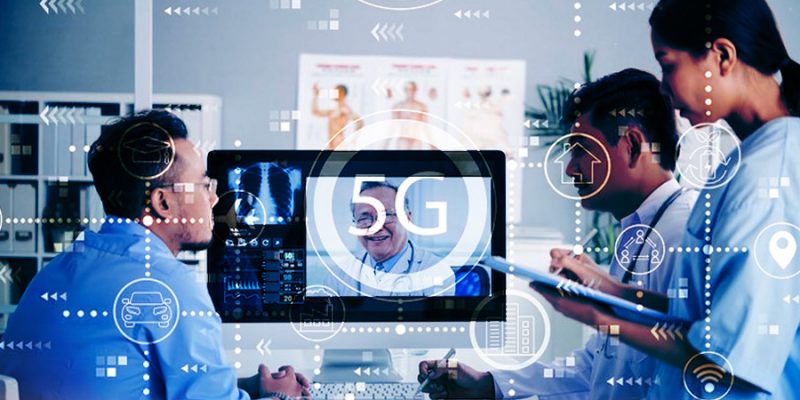
Advantages of 5G in healthcare industry that will transform the healthcare IoT wearables
5G in healthcare is a lot more than just a numbers game. Due to the industry’s persistently hampered adoption of new technologies by a complex regulatory environment and deeply ingrained legacy systems, But all of this is about to change thanks to 5G in healthcare, which is expected to improve patient experiences and care quality while also lowering costs and increasing operational efficiency. Ericsson projects a $76 billion revenue opportunity for healthcare providers as a result of 5G’s transformational potential. For smarter, more connected patient care, the combination of IoT wearable and 5G could expand the use of Wearable healthcare devices.
IoT: What is it?
IoT device is an architectural concept in which all data-generating and -using devices are connected by a single network. Process and function monitoring, management, and control are now possible in ways that were previously unimaginable. Situational awareness, automation, streamlining, and simplification of its use cases are all made possible by the healthcare IoT device paradigm.
What’s 5G?
If 2G was all about texting and voice, 3G was all about texting and voice; 4G was the same as 3G, but it was faster. It is said that 5G is the faster technology of the next generation. A full-length HD movie can be downloaded in a matter of seconds thanks to its speed. However, the wireless network of the fifth generation offers a lot more than just quick downloads.
The “internet of things” or IoT devices, such as connected street lamps, traffic lights, driverless cars, automated machinery, and many more, have begun to be considered the nirvana for 5G in healthcare, which is not surprising.AI-based digital capabilities, autonomous operations, virtual reality, and drones are just a few of the solutions that will use 5G in healthcare to increase productivity significantly and speed up innovation. Additionally, a number of previously restricted use cases can now be made possible by 5G thanks to its improved performance and throughput.
A 5G in healthcare will enable even the smallest devices to perform high-level computations, significantly exceeding what they currently offer, thanks to the industry’s millions of connected Wearable healthcare devices and sensors. In addition, this entails the development of entire digital ecosystems capable of accelerating medical research, diagnosis, and treatment.
The widespread use of 5G will accelerate some of these scenarios.
Intra-hospital monitoring
The continuous collection, reporting, and transmission of patient data to a remote monitoring center by hospitals will be made simpler by Wearable healthcare devices. Patch-based monitoring devices that are capable of transmitting patients’ biometric data, such as their electrocardiogram and blood pressure, back to the monitoring center are already being developed. The use of 5G in healthcare will streamline the entire procedure.
Scale.
The purpose of 5G in healthcare is to scale to networks with a lot of devices and a lot of traffic. The scalability and performance of 5G cannot be matched by any other current or emerging wireless technology.
Performance
In comparison to many other technologies, 5G in healthcare has a higher capacity and lower latency. This indicates that it has improved performance and can support a greater number of Wearable healthcare devices and data.
Pervasiveness
Nearly everywhere is or will soon be using 5G in healthcare. That is unquestionably advantageous because people’s Wearable healthcare devices will be connected no matter where they go. Numerous other technologies are less widespread, require close proximity to other devices or infrastructure, and are more restricted geographically.
Scale-savings effects
Tens of billions of users will be supported by 5G in healthcare. Wearable healthcare devices will increasingly have access to inexpensive 5G modems at lower prices.
Standardization
The 3rd Generation Partnership Project (GPP) developed the standards-based technology known as 5G in healthcare. Because of this, a phone functions no matter where it is used. Because they are all built to the same standards, all 5G networks that a phone encounters are compatible with one another.
The healthcare wearable’s processing time would be cut down if it had 5G. Now that the Wearable healthcare device can talk directly to internet-based data stores, applications based on mobile phones can still access them through the cellular network. Authorized third parties also have easier access to this information. In addition, rather than traversing multiple devices, this sensitive health data is now only transmitted over the more secure 5G network.
The healthcare sector now has an unprecedented opportunity to transform patient care thanks to Wearable healthcare devices. The ability to monitor patients in a way that was previously thought impossible is made possible by wearable, which has the potential to significantly enhance diagnostic capabilities, treatment options, and patient outcomes.
The future of Healthcare IoT devices and 5G is clear. 5G for healthcare wearable is a no-brainer. Although it doesn’t completely address every issue that a Healthcare IoT device presents, it does begin to address several significant issues. The fact that the majority of current healthcare wearable rely on short-range technologies like Bluetooth to connect to the wearer’s mobile device is the biggest obstacle.
Bottom line
The healthcare wearable industry will soon begin to adopt 5G.Since embedded 5G chipsets are becoming less expensive, it will become increasingly cost-effective. The majority of the biggest problems with Healthcare IoT and large-scale healthcare wearable are addressed, at least in part, by 5G in healthcare.



















